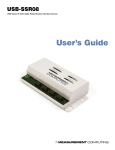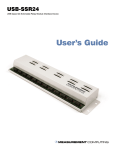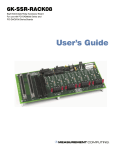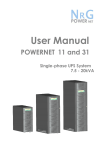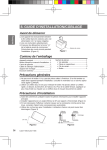Download Bang & Olufsen BeoLab 9 Service manual
Transcript
BeoLab 9 Type 6217 Service Manual English German, French, Italian, Spanish, Danish, Dutch and Japanese versions are available in the Retail System This Service Manual must be returned with the defective parts/back-up suitcase ! CONTENTS Survey of modules ..................................................................... 1.1 How to service ........................................................................... 1.2 Fault flow chart ......................................................................... 2.1 Adjustments .............................................................................. 3.1 Repair tips ................................................................................. 3.2 Final check after repair . ............................................................. 3.3 Replacement of modules ........................................................... 4.1 Specification guidelines for service use ....................................... 5.1 Block diagram . .......................................................................... 6.1 Wiring diagram . ........................................................................ 6.3 Available parts ........................................................................... 7.1 Survey of modules 1. Survey of modules 3 4 7 999 PCB1 PCB2 PCB3 PCB4 PCB5 PCB7 999Module Cross Over LC-Filter LED Power Supply ICEpower Amplifier NTC Chassis complete, incl. PCB1, PCB2, PCB5 1. How to service How to service Strategy BeoLab 9 has been split-up into as few service items as possible. Each servicefriendly item is packed individually, prepared for worldwide transport, and has a separate seven digit spare part number to be found in the Bang & Olufsen Retail System or the Service Manual. An exploded view drawing shows the service spare parts. The back-up suitcase holds all necessary electrical modules for front-line repair of one loudspeaker in e.g. the customers home. Cabinet parts must be brought with you separately, if to be replaced in the customers home. 1. 2. 3. 4. An adequate fault description must be returned with each replaced part. For this purpose, use the Module Repair form or the form in the Retail Order System under Exchange Module. To help the Bang & Olufsen Module Repair department it is very important to answer the following questions: Which products are in the setup? Which software versions are used in these products? How are the products linked together? What happens in the actual situation? All service repair will be on module level by means of the back-up suitcase. Service Manuals in other languages can be found in the Retail System as PDF-files. Preparations before service Always remember to download the latest version of the Service Manual. Fault description must be returned with the replaced parts. Use the Module Repair form or the form in the Retail Order System, Exchange Module. Fault explanation and demonstration Before troubleshooting is initiated, let the customer demonstrate the fault, if possible. Recommended tools for service White gloves. Soft lint-free cloth. Multimeter. How to service 1. Handling and cleaning Static electricity Static electricity may damage the product. STATICELECTRICITY MAYDESTROYTHE PRODUCT Static-protective field service kit. A static-protective field service kit must always be used when the product is disassembled or modules are being handled. Follow the instructions in this Service Manual and use the ESD-mat for both old and new modules. Please note: When mains voltage on the product is required, remove the connection between the product and the ESD-mat. ESD The chassis or modules must always be connected to the static-protective field service kit or placed in an ESD-proof bag. Symbol of safety components When replacing components with this symbol, the same type has to be used, also the same values for ohm and watt. The new component is to be mounted in the same way as the replaced one. Transport and handling - - It is recommended to: use the product cover when transporting the product. do not move the product when it is operating. Cleaning Please refer to the chapter “Final check after repair” or the User’s guides. 1. Fault flow chart Fault flow chart No red light in STANDBY . ..................................................... No sound, but green LED is OK . ........................................... No sound from woofer, but tweeter and midrange is OK ...... No sound from midrange, but tweeter and woofer is OK ...... No sound from tweeter, but midrange and woofer is OK ...... No function of the PCB7, NTC .............................................. No function of S1 and S2 ..................................................... 2.2 2.4 2.4 2.5 2.5 2.6 2.6 2. 2. Fault flow chart No Fault symptom: - No red light in STANDBY Note: Ground is chassis Possible causes: - Fuse F1 - PCB4, Power Supply - Module 999, Amplifier Connect a Master Link cable from e.g. a BeoSound 4, to BeoLab 9. Make sure that S101 is set to either L or R. Connect mains to BeoLab 9. Is there red light in the LED on top of BeoLab 9? Confirm mains in the mains wire Reconnect mains Confirm mains on PCB4, Power Supply P13 pin1 and 2 If possible, check fuse F1 on PCB1, Cross Over Confirm 5V on PCB4, Power Supply P14 pin1 Replace PCB4, Power Supply Confirm 4.2V on PCB1, Cross Over P9 pin 2 Replace Module 999, Amplifier Replace PCB3, LED Replace fuse F1 Yes Fault flow chart No Select e.g. Radio or CD on the Audiomaster, and press GO on Beo4 Does BeoLab 9 turn on (Green light in LED) Go to next page Confirm 5V on PCB4, Power Supply P14 pin 7 Check Power Link cable and Audiomaster. Reconnect/replace if nescessarry. (This is not covered in this fault flow chart) Confirm -12V on PCB4, Power Supply P14 pin 3 Replace PCB4, Power Supply Confirm 12V on PCB4, Power Supply P14 pin 5 Replace PCB4, Power Supply Confirm 44V on PCB4, Power Supply P15 pin 4 Replace PCB4, Power Supply Confirm -44V on PCB4, Power Supply P15 pin 5 Replace PCB4, Power Supply Confirm 66V on PCB4, Power Supply P15 pin 6 Replace PCB4, Power Supply Confirm approx 4.7V on PCB4, Power Supply P14 pin 9 Replace PCB4, Power Supply Replace Module 999, Amplifier Yes 2. 2. Fault flow chart No From previous page Yes Fault symptom: - No sound, but green LED is OK Possible causes: - Module 999, Amplifier Is there no sound, but the green LED is OK? Go to box further down on page Replace Module 999, Amplifier Note: It wil give the best result if it is possible to use an audio test CD with pure sine waves and an oscilloscope, when measuring on the woofer or midrange. From above Fault symptom: - No sound from woofer, but tweeter and midrange is OK Warning: Be very careful, when measuring on the woofer, because there is approx 35Vdc on both input terminals. Make sure to use a differential probe, or make sure that the oscilloscope and the product is not connected to earth. Possible cause: - Woofer - Module 999, Amplifier Visual confirm cable connection between woofer and Module 999, Amplifier Turn volume on the Audio Master up to 50. Confirm an AC-Sound signal by means of the Bar-graph on the multimeter or an oscilloscope, when measuring across the woofer input terminals. Remove mains from the product. Remove the black wire from the woofer. Measure the resistance across the woofer terminals: Approx 2.9 ohm? Replace woofer Replace Module 999, Amplifier Reconnect/replace cable Fault flow chart No Fault symtom: - No sound from midrange, but tweeter and woofer is OK Note: It wil give the best result if it is possible to use a audio test CD with pure sine waves and an oscilloscope, when measuring on the woofer or midrange Yes Possible cause: - Midrange - Module 999, Amplifier Visual confirm cable connection between midrange and Module 999, Amplifier Turn volume on the Audio Master up to 50. Confirm an AC-Sound signal by means of the Bar-graph on the multimeter or an oscilloscope, when measuring across the midrange input terminals. Remove mains from the product. Remove the black wire from the midrange. Measure the resistance across the midrange terminals: Approx 6.1 ohm? Replace midrange Reconnect/replace cable Replace Module 999, Amplifier Fault symtom: - No sound from tweeter, but midrange and woofer is OK Possible cause: - Tweeter - Module 999, Amplifier Visual confirm cable connection between tweeter and Module 999, Amplifier Turn volume on the Audio Master up to 50. Confirm an AC-Sound signal by means of the Bar-graph on the multimeter or an oscilloscope, when measuring between PCB1, Cross Over P10 pin 1 and ground. Remove mains from the product. Remove the connector on PCB1, Cross Over P10. Measure the resistance between the orange and white wire: Approx 6.6 ohm? Replace tweeter Replace Module 999, Amplifier Reconnect/replace cable 2. 2. Fault flow chart No Fault symptom: - No function of the PCB7, NTC Possible cause: - PCB7, NTC - Cable W4 - Module 999, Amplifier Yes Fig1 Red Black Is the loudspeaker in protection mode? Visual confirm cable connection between Module 999, Amplifier and PCB7, NTC Reconnect/replace cable To confirm correct operation of the NTC, measure approx. 9.35V DC at normal room temperature, as shown in fig 1 (When the temperature is rising, the DC voltage is going towards 0) Note: When the loudspeaker goes into protection mode, it is nescessarry to disconnect mains and wait one minute before connecting it again. Fault symptom: - No function of S1 and S2 Possible cause: - Module 999, Amplifier Is there no function of switch S1 and/or S2? Replace Module 999, Amplifier Replace PCB7, NTC Replace Module 999, Amplifier Adjustments 3.1 Adjustments Adjustments described Speaker driver adjustment. The speakers are individually measured and the speaker driver must be adjusted accordingly. Adjustment must be performed when either speaker or speaker driver is replaced. Access to adjustment points The adjustment points are placed on the socket panel on the back of the product. 456 456 23 23 456 23 1 9 01 9 78 + WO 78 + MR 0 9 01 TW 78 + Speaker adjustment table Speaker value from label on speaker 1.8 – 2.3 1.3 – 1.7 0.8 – 1.2 0.3 – 0.7 -0.2 – 0.2 -0.3 – -0.7 -0.8 – -1.2 -1.3 – -1.7 -1.8 – -2.2 -2.3 – -2.5 Switch position 0 1 2 3 4 5 6 7 8 9 TW: Tweeter MR: Midrange WO: Woofer 3.2 Repair tips Repair tips Hum in speaker when no music is played The Power Link cable must be of type MK III or higher. Power Link MK III The ground connection in Power Link cable lower than MK III may be insufficient for optimum sound performance. Standby LED The standby LED indicates the status of the BeoLab 9. Standby LED STATUS Red BeoLab 9 is in standby. Green BeoLab 9 is operating. Orange BeoLab 9 is shut down due to thermal overload. If the LED Status is orange, turn off and disconnect the product from the mains. Wait for minimum 5 minutes for the speaker to cool down. Connect mains and turn on BeoLab 9. If the LED status still is orange the fault may be due to: 1. Woofer protection – perform speaker check. 2. Tweeter protection – perform speaker check. 3. Midrange protection – perform speaker check. 4. NTC-board or connection on one of the woofers. Access the NTC-board by dismantling the woofer. 4. Power supply failure. Final check after repair 3.3 Final check after repair Final check after repair The final check after repair describes the activities that are needed to ensure the product will be returned in perfect condition to the customer. The content is: – Insulation test. – Restore setup. – Final cleaning of the product. Insulation test The product must be insulation tested after having been dismantled. Make the test when the set has been reassembled and is ready to be returned to the customer. Flashover must not occur during the test. Make the insulation test as follows: Short-circuit the two pins of the mains plug and connect them to one of the terminals of the insulation tester. Connect the other terminal to ground on the Power Link socket. NOTE! To avoid damaging the product it is essential that both terminals of the insulation tester have good contact. During the test the current must not exceed 5 mA. Slowly increase the voltage on the insulation tester until a voltage of 2.5 kV (ac) is obtained. Maintain the voltage level for one second, then slowly decrease the voltage to 0 V (ac). Restore setup Ensure that, – The F/W/C switch is in correct position. – The plug is inserted over the standby LED. – The Power Link cable is a MK III or higher. Check sound Ensure that all speakers are OK. Clean the product Clean dusty surfaces using a dry soft cloth. If necessary, remove grease stains or persistent dirt with a lint-free, firmly wrung cloth, dipped in a solution of water containing only a few drops of mild detergent such as washing-up liquid. The loudspeaker front grill may be cleaned with a vacuum cleaner with a soft brush nozzle, and set to the lowest level. 3.4 Replacement of modules Replacement of modules Modules that can be replaced BeoLab 9 in service position ........................................ 4.2 Replace PCB3, LED ..................................................... 4.4 Replace PCB4, Power Supply ...................................... 4.6 Replace 999Module, Amplifier . .................................. 4.7 Replace tweeter . ........................................................ 4.9 Replace midrange ..................................................... 4.11 Replace woofer ........................................................ 4.12 Replace rubber foot .................................................. 4.13 Warning – Static electricity Static electricity may damage the product. A static-protective field service kit must always be used when the product is disassembled or modules are being handled. ESD ESD-Mat Notice! All modules must be placed on the ESD-mat or in an ESD-proof bag. Purpose of replacement of modules Short instructions for replacement of the available modules, with reference to additional illustrations: - The correct sequence for replacing modules. - Text and illustrations. - Reference to adjustment. Modules that do not require any special procedure may be shown as only illustrations. After replacement of drivers After replacing a driver, see Adjustments and Repair tips. 4. 4. BeoLab 9 in service position - Remove cover - Remove cables connected to BeoLab 9 2x 3mm - Remove cover, top - Use Special tool - Remove screws for lens 3x 2.5mm BeoLab 9 in service position - Gently lift off lens - Pull off fabric frame 4. 4. Replace PCB3, LED - Remove cover - Remove cables connected to BeoLab 9 2x 3mm - Remove cover, top - Use Special tool - Remove screws for lens 3x 2.5mm Replace PCB3, LED - Gently lift off lens - Remove screws and pull of lens top Remove cable 3P25 3x TX20 1 2 3 - Remove screws and pull off PCB3, LED with chassis 4x TX10 - Remove screws for PCB3, LED 3x TX10 4. 4. Replace PCB4, Power Supply + 4.2 BeoLab 9 in service position - Remove screws 12x TX20 - Flip down heat sink as shown - Remove cables 4P15 4P14 4P13 - Remove screws 9x TX10 Replace 999Module, Amplifier + 4.2 BeoLab 9 in service position - Remove screws 12x TX20 - Flip down heat sink as shown - Remove cables from woofer - Remove cables as shown 1P10 1P9 4P15 4P14 4. 4. Replace 999Module, Amplifier - Remove screws as shown 3x TX20 - Remove screws as shown 3x TX10 - Remove cable on backside of 999Module, Amplifier 1P2 Replace tweeter - Remove cover - Remove cables connected to BeoLab 9 2x 3mm - Remove cover, top - Use Special tool - Remove screws for lens 3x 2.5mm 4. 4.10 Replace tweeter - Gently lift off lens - Remove screws and pull of lens top Remove cable 3P25 3x TX20 1 2 3 - Remove tweeter cover - Remove screws for tweeter 3x TX10 Replace midrange + 4.2 BeoLab 9 in service position - Remove screws 4x TX20 - Remove cables 4.11 4.12 Replace woofer + 4.2 BeoLab 9 in service position - Remove screws 4x TX20 - Remove cables (remember NTC) Replace rubber foot - Remove screw 1x TX10 - Pull off bracket - Pull off rubber foot 4.13 4.14 Specification guidelines for service use Specification guidelines for service use BeoLab 9 Type number 6217 5. Dimensions W x H x D 775mm x 400mm x 300mm Dimensions W x H x D, incl. packaging two pcs. in one carton box1004mm x 800mm x 600mm Weight16.6 kg Weight, incl. packaging 44.9 kg Cabinet finish Black cloth, aluminium Blue cloth, aluminium Dark grey cloth, aluminium Red cloth, aluminium Mains 90-240Vac Power consumption 65W (IEC60065) 25W typical < 0,5W in standby Power amplifier, bass 400W, 4 ohm, class D ICEpower Power amplifier, midrange100W, 6 ohm, class AB Power amplifier, treble100W, 8 ohm, class AB Effective Frequency range 30 - 20,000 Hz Crossover frequency180/2000 Hz Cabinet principle Closed box Net volume, bass18 litres Net volume, midrange 4 litres Woofer10” / 250mm cone Midrange 5” / 125mm cone Tweeter 3/4” / 19mm dome in acoustic lens Bass equalization ABL (Adaptive Bass Linearization) Input sensitivity (Power Link) and (line)125mV @ 91dB SPL Switch off time (line) Automatic on /off (up to 3min) Indication On/Off LED placed in the acoustic lens Operation Switch for Free standing - Against wall - In corner Switch for Left - Right - Line (via PL plug) Protection Thermal protection of all drivers ABL system protects the bass unit against mechanical damage Connections Power Link Two (use semi-balanced PL cable type MKIII, or fully mounted PL cable) POWER LINK Pin 1 Pin 2 Pin 3 Pin 4 Pin 5 Pin 6 Pin 7 Pin 8 Line-in Mains Via PL using Line-to-PL adaptor cable Subject to change without notice PL ON => 2.5V, OFF = < 0.5V Signal GND Audio L out 0V - 6.5V RMS PL speaker ON => 2.5V, OFF = < 0.5V Audio R out 0V - 6.5V RMS Data: High > 3.5V, Low < 0.8V Data GND Not used One (two pin male shaver plug type) 5. Block diagram 6.1 6.1 Block diagram 6.1 Block diagram Module 999 PCB5 PCB4 6.2 6.2 6.2 Wiring diagram 6.3 6.3 Wiring diagram 6.3 Module 999 Amplifier Tweeter + Lens 4 > > > > > > < < > > > > > > LED < < > JST VH JST VH < < 1 W2 8 ohm > Midrange > > > > JST 2mm > > > > > > JST SDN Soldered into PCB Molex MLX Cross Over > > Micro-Match Soldered into PCB > > > > > > > > W4 7 W5 > < W6 > > > > < > > > > < > > > > JST PH JST SAN Soldered into PCB Micro-Match W7 LC-Filter > > < < > > < < < < > > < < > > 5 ICE-Power Amplifier Molex Micro-Fit 2 JST SDN Soldered into PCB > > JST VH > > > > > > > > > > < Woofer JST XA JST 2mm W3 4 ohm 3 W1 Power Supply NTC 8 ohm > Micro-Match Soldered into PCB Micro-Match W9 > > W8 > > > > 7.1 Available parts BeoLab 9 Available parts 7.1 7.1 Available parts 9001 9 9002 9003 Incl. pos. no. 1 9015 Incl. pos. nos. 9016, 9017, 9020, 9021, 9, 10 9 9 10 10 9017 1 9004 9016 1 2 10 10 6 10 10 6 9017 9005 6 3 9006 3 10 10 3 3 6 9017 6 10 9007 10 9008 9017 6 3 3 6 3 10 10 Incl. pos. no. 9008 9017 6 6 9018 9010 9 3 9011 9018 9004 9012 9023 9017 2 2 3 9009 Incl. pos. nos. 9018, 9019, 9022, 9024, 3, 4, 11, 9, 13 4 * 4 4 Incl. pos. nos. 9010, 9011 9019* 10 9020 5 6 5 9 4 4 9 6 * 13 11 11 6 9013 6 6 3 * 9021 5 9 6 9024 13 9025 9022 6 11 7 6 8 7 11 11 11 4 6 9014 6 6 6 999 3 3 6 6 6 11 11 11 11 * 9026 11 9027 12 12 3 12 Incl. pos. no. 9022 Available parts 7.2 BeoLab 9 Survey of screws etc. 9001 9002 9003 9004 9005 9006 9007 9008 9009 9010 9011 9012 9013 9014 9015 9016 9017 9018 9019 9020 9021 9022 9023 9024 9025 9026 9027 3458152 3321047 3321048 3321049 3321050 3131109 3332007 3152321 3912009 3459508 3947303 8480084 3947306 3947318 3131108 8480080 8480082 3400061 3947350 3332010 3151911 3152235 3947305 3152154 2954004 3947304 3358277 3151552 3160408 6100273 6100329 6100307 6100332 6100386 6100331 6100047 6270688 Cover, top Fabric frame, black Fabric frame, dark grey Fabric frame, blue Fabric frame, red Lens, top incl. pos. no. 1 Damping material Chassis w/light guide Acoustic felt Cover, tweeter Gasket Tweeter Gasket Gasket Lens, bottom incl pos. nos. 9010, 9011 Midrange Woofer 10” Cabinet incl. pos. nos. 9016, 9017, 9020, 9021, 9, 10 Tape/foam 3 x 7mm – 10m Damping material Guide Clips f/wire Gasket, set Bracket f/foot Rubber foot Gasket Heat sink incl. pos. nos. 9018, 9019, 9022, 9024, 3, 4, 11, 9, 13 Wire holder Cover Mains wire, EU Mains wire, UK Mains wire, US Mains wire, AUS Mains wire, KOR Mains wire, JPN Mains wire, CHN Powerlink cable, black, 5m 3Module 8003276 PCB3, LED 4Module 8003325 PCB4, Power Supply 7Module 8100090 PCB7, NTC 999Module8052273 F1 6600177 999Module, Amplifier consists of: PCB1 - PCB2 - PCB5, incl. pos. no. 9022 Fuse T 5A 250V 1 2 3 4 5 6 7 8 9 10 11 12 13 Gasket Screw 3 x8 mm Screw 3 x 10mm Screw 4 x 10mm Screw 4 x 12mm Screw 4 x 12mm Screw 3 x 8mm Lock washer Bushing Screw 3 x 10mm Screw 3 x 10mm Screw 4 x 55mm Solder pin 2930112 2052040 2054060 2058092 2019025 2019021 2058026 2625002 2930178 2052011 2054043 2015005 7530118 7.3 Available parts Wire bundles W2 6277985 Wire from PCB1, P2 – PCB4, P13 Parts not shown 3395313 3376000 3040017 Back-up suitcase Product cover Special tool Accessories 6270856 6270433 Cable, RCA-phono to PL Line-in, black, 5m Adapter, mini-jack/male – RCA female x 2 Packing 3393016 3396425 3392768 Outer carton, top-bottom Packing, complete Pallet Available documentation See Retail Ordering System Bang & Olufsen DK-7600 Struer Denmark Phone +45 96 84 11 22* Fax +45 97 85 39 11 3538063 02-07









































